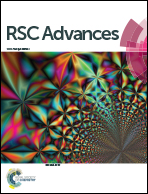Highly specific probe for dual-emissive mitochondrial imaging based on a photostable and aqueous-soluble phosphonium fluorophore†
Abstract
In recent years, fluorescent mitochondrial imaging has emerged as a powerful tool for monitoring the biological processes of mitochondria with high spatial and temporal resolution. However, conventional fluorescent reagents for mitochondrial imaging usually suffer from poor photostability and poor solubility in water as well as complex molecular structure and multi-step synthesis. Therefore, the development of an efficient method to construct specifically mitochondria-targeted molecules with superior photostability and aqueous solubility is in high demand for the study of mitochondrial functions. In this manuscript, a new type of aqueous-soluble fluorescent probe based on the perylene skeleton has been developed efficiently and exhibits high specificity to mitochondria with dual-emissive luminescence in living cells. To the best of our knowledge, this is the first report of a dual-emissive probe for specific mitochondrial imaging. Moreover, this perylene-based probe also exhibits superior photostability. The dual-emissive imaging, high specificity, and superior photostability as well as the efficient preparation make this perylene-based phosphonium fluorophore highly attractive as a fluorescent probe for mitochondrial imaging.


 Please wait while we load your content...
Please wait while we load your content...